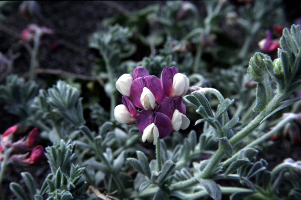This species is in the legume, or pea family. The genus Lathyrus is large, with approximately 160 species, and found all over the globe. This group of species is known as the "sweet peas" or "wild peas".
Photo Credit: © Gordon Leppig & Andrea J. Pickart via Wikimedia Commons
Lathyrus littoralis
Common Name: silky beach pea
Plant Functional Group: Forb
Class > Order > Family: Magnoliopsida > Fabales > Fabaceae
What does the species look like?
This species is a perennial herb with silky grey wooly leaves. It can have an upright or spreading form. Leaves are 1 to 2 centimeters long and have 4 to 8 small overlapping leaflets with small tough tendrils. The purple-pink and white flowers have prominant delicate veination. Flowers are found in tight clusters of 4 to 8, and are 15 to 18 millimeters wide. The fruit is an oval hairy pea-like pod.Lathyrus littoralis is found on beaches and open coastal dunes. It is found along the coastline from California to British Columbia at elevations less than 5 meters.
Where is the species found?
States & Provinces
BC, CA, OR, WA
Which phenophases should I observe?
Do you see...?
Leaves
Initial growth More...
Leaves More...
Flowers
Flowers or flower buds More...
How many flowers and flower buds are present? For species in which individual flowers are clustered in flower heads, spikes or catkins (inflorescences), simply estimate the number of flower heads, spikes or catkins and not the number of individual flowers.
Less than 3 3 to 10 11 to 100 101 to 1,000 More than 1,000
Open flowers More...
What percentage of all fresh flowers (buds plus unopened plus open) on the plant are open? For species in which individual flowers are clustered in flower heads, spikes or catkins (inflorescences), estimate the percentage of all individual flowers that are open.
Less than 5% 5-24% 25-49% 50-74% 75-94% 95% or more
Fruits
Fruits Lathyrus littoralis , the fruit is a hairy pod that changes from green to tan, light brown or light reddish-brown and splits open to expose the seeds. Do not include empty pods that have already dropped all of their seeds.More...
How many fruits are present?
Less than 3 3 to 10 11 to 100 101 to 1,000 More than 1,000
Ripe fruits Lathyrus littoralis , a fruit is considered ripe when it has turned tan, light brown or light reddish-brown and has split open to expose the seeds. Do not include empty pods that have already dropped all of their seeds.More...
What percentage of all fruits (unripe plus ripe) on the plant are ripe?
Less than 5% 5-24% 25-49% 50-74% 75-94% 95% or more
Recent fruit or seed drop More...
How many mature fruits have dropped seeds or have completely dropped or been removed from the plant since your last visit?
Less than 3 3 to 10 11 to 100 101 to 1,000 More than 1,000
What do these phenophases look like?
There is currently no photoguide available for this species. If you'd like help us create one, use the guidance document and species template provided here . Then send it via email to education@usanpn.org when it is complete.
